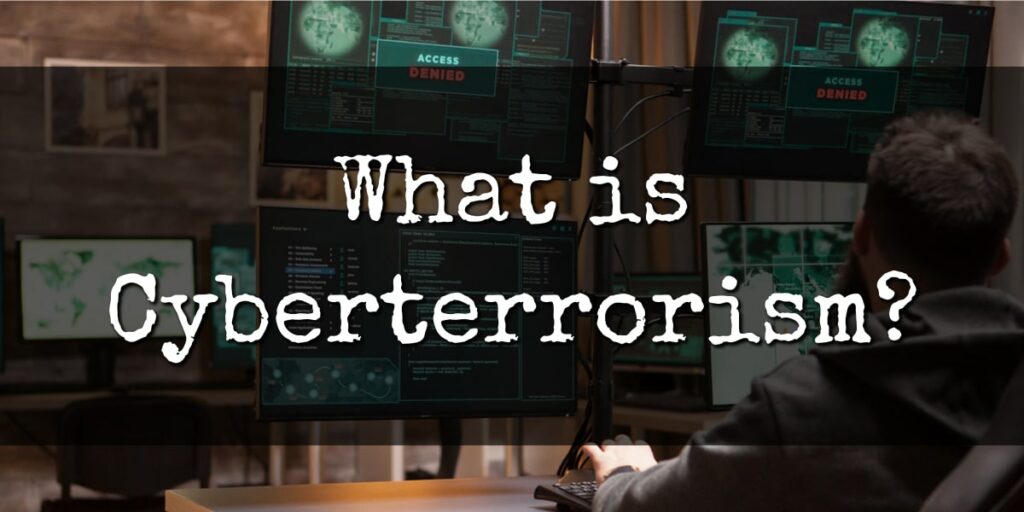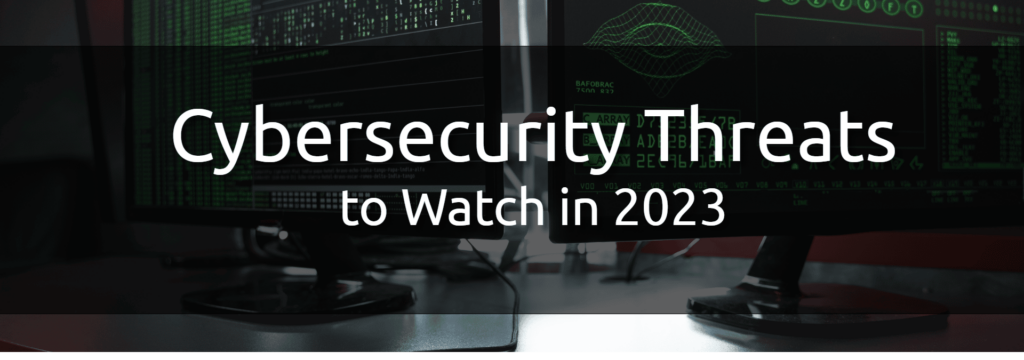As our world grows increasingly connected, the threat of cyberterrorism looms larger than ever. With the power to disrupt nations, cripple critical infrastructure, and steal sensitive information, cyberterrorists have become a force to be reckoned with.
But what is cyberterrorism, exactly, and how does it impact individuals, businesses, and governments?
In this guide, we’ll delve deep into the ever-evolving world of cyberterrorism, discussing its origins, motivations, targets, and strategies to combat it. Prepare to enter the shadowy realm of cyber warfare, and learn how the future of cyberterrorism may shape our world.
On This Page:
Defining Cyberterrorism

While there is no universally accepted definition, the U.S. Patriot Act and the Computer Fraud and Abuse Act define cyberterrorism as an unlawful attack or threat of attack against computers, networks, and the information stored therein, with the intent to intimidate or coerce a government or its people to further political or social objectives.
Cyberterrorists can be state-sponsored or non-state actors who utilize cyber attacks to achieve their objectives, often driven by political, religious, or ideological agendas.
The objectives of cyber terrorists extend beyond mere digital disruption, as they use computer or communication networks to fund their operations, educate their followers, and plan cyber terror attacks. With the potential to cause widespread chaos, undermine essential infrastructure, and even result in physical destruction and fatalities, the significance of cyberterrorism cannot be overstated.
IBM estimates the average cost of a data breach to businesses in 2023 at $4.45 million, highlighting the importance of implementing robust security measures to protect against such attacks.
Controversies in Definition
The definition of cyberterrorism is rife with controversy, as experts differ on whether to include cybercrime or focus solely on politically motivated attacks. In the realm of cyber terrorism, attackers can employ a variety of methods, ranging from denial of service to website defacement and even targeting command and control systems of critical infrastructure.
Types of Cyber Attacks
Cyberterrorism encompasses a wide range of methods, including cyber attack techniques such as:
- Distributed denial of service (DDoS) attacks
- Malware
- Social engineering
- Phishing campaigns
These attacks are carried out with the intent to create disruption and inflict damage. For example, DDoS attacks involve overwhelming a specific computer or Internet service with communication requests, rendering the service inoperable. Cyberterrorists employ these and other techniques, such as viruses and social engineering, to achieve their objectives.
Recent examples of high-profile cyberterrorism attacks include the Robinhood online trading platform and the banking industry, which experienced a staggering 1,318% increase in ransomware attacks in a single year. These incidents serve as a stark reminder of the ever-present danger posed by cyber terrorists and the importance of remaining vigilant in the face of this growing threat.
Evolution of Cyberterrorism

The history of cyberterrorism stretches back to the 1980s, with its roots in the early days of the internet. Since then, cyberterrorism has evolved, becoming more sophisticated and frequent due to technological advancements and our increased reliance on digital infrastructure. The term “cyberterror” itself was coined by Barry C. Collin, highlighting the growing recognition of this new form of terrorism.
The trend in cyberterrorism attacks has been on the rise, with a notable increase in the frequency and destructiveness of attacks since 2020.
Notable Cyberterrorism Incidents
Throughout the history of cyberterrorism, several noteworthy incidents have captured the world’s attention. The Morris Worm, unleashed in 1988, was the first computer worm transmitted over the internet and caused damages estimated at up to $100 million, despite not being intended as a malicious attack.
Another high-profile incident occurred in 2014 when the Guardians of Peace infiltrated Sony Pictures’ computer networks and released confidential information in retaliation for the studio’s planned release of The Interview, a movie critical of North Korean leader Kim Jong-un.
More recently, the WannaCry ransomware cyber attack in 2017 infected over 200,000 computers across 150 countries, exploiting a vulnerability in Microsoft Windows and demanding ransom payments to decrypt the affected files.
These incidents demonstrate the evolving nature of cyberterrorism and serve as a reminder of the potential consequences of failing to adequately protect against such threats.
State-Sponsored Cyberterrorism
State-sponsored cyberterrorism is a growing concern for national security. These attacks are funded, supported, or executed by a government or state, often with the intention of causing harm to other nations, organizations, or individuals for political, economic, or strategic objectives. Some characteristics of state-sponsored cyberterrorism include:
- Attacks carried out by Advanced Persistent Threats (APTs), highly skilled and sophisticated hacker groups
- Targeting of critical infrastructure, government systems, and sensitive data
- Use of advanced techniques and tools to evade detection and attribution
It is important for government agencies, as well as other organizations, to be aware of the threat posed by state-sponsored cyberterrorism and take appropriate measures to protect their systems and data.
Countries like China and Russia are frequently accused of supporting cyberterrorist activities, highlighting the geopolitical implications of state-sponsored cyberterrorism. As the stakes continue to rise, the importance of international cooperation and collaboration in combating cyberterrorism cannot be overstated.
Targets and Motivations of Cyberterrorists

Cyberterrorists, often associated with terrorist groups, target a variety of entities, including governments, financial institutions, and critical infrastructure. Driven by ideological, political, or financial motivations, their primary objectives are to impair the adversary’s operational capability, tarnish the public image of a group or nation, coerce targets to alter their loyalties, and demonstrate the ability to inflict significant harm.
The potential ramifications of a successful cyber attack could be catastrophic, resulting in substantial decreases in social and economic stability. A nation or enterprise could be brought to a halt if essential infrastructure and business operations are compromised.
As cyber terrorists continue to adapt and evolve, staying informed and vigilant is crucial in protecting against these threats posed by cyber terrorism groups.
Ideological and Political Goals
Cyberterrorism can further political, religious, or ideological agendas by causing physical and psychological harm to civilians. Techniques used to damage or falsify a target’s reputation involve defacing websites and disseminating false information about the target through electronic channels, such as social media and web pages.
By utilizing these tactics in cyber warfare, cyberterrorists can undermine the operational capacity of their targets, manipulate public opinion, and gain leverage in political or ideological disputes. As the line between the digital and physical worlds continues to blur, the potential impact of these attacks becomes increasingly significant.
Economic and Financial Impact
The economic and financial impacts of cyberterrorism are far-reaching and can be devastating. Some of the impacts include:
- Financial losses estimated to be close to $600 billion annually, which is nearly one percent of global GDP
- Market uncertainty
- Loss of tourism
- Increased insurance claims
- Necessitate increased cybersecurity measures in various sectors, including the financial industry
Furthermore, cyberattacks can result in intellectual property theft, which can have long-term economic consequences.
Strategies for Combating Cyberterrorism

Combating cyberterrorism requires a multi-faceted approach, as the threats posed by cyber terrorists are diverse and ever-evolving. Implementing cybersecurity best practices is essential, but it is only one piece of the puzzle. International cooperation and collaboration among law enforcement agencies play a crucial role in tracking and apprehending cyber terrorists and sharing vital intelligence.
17 Cybersecurity Best Practices
To defend against cyber threats, organizations should implement a range of cybersecurity best practices. These include:
- Implement a Robust Security Framework: Utilize well-established security frameworks like NIST or ISO 27001 to guide the organization’s security policies and procedures.
- Regularly Update Software and Systems: Ensure that all critical infrastructure systems, applications, and devices are up-to-date with the latest security patches.
- Use Multi-Factor Authentication (MFA): Require multiple forms of identification before granting access to sensitive systems.
- Educate Employees: Conduct crisis management training sessions to educate employees about the risks of phishing, social engineering, and other common attack vectors.
- Implement Network Segmentation: Divide the network into segments to limit an attacker’s ability to move laterally through the system.
- Utilize Intrusion Detection Systems (IDS) and Intrusion Prevention Systems (IPS): Monitor network traffic for suspicious activities and take immediate action if an anomaly is detected.
- Regular Security Audits and Assessments: Conduct periodic security assessments to identify vulnerabilities and areas for improvement.
- Implement a Strong Firewall and Endpoint Protection: Utilize firewalls to control incoming and outgoing network traffic and endpoint protection to secure individual devices.
- Data Encryption: Encrypt sensitive data both at rest and in transit to make it more difficult for unauthorized parties to access.
- Develop an Incident Response Plan: Have a well-documented and practiced incident response plan to ensure that the organization can respond quickly and effectively to a data breach.
- Utilize Threat Intelligence: Stay informed about the latest threats and vulnerabilities by subscribing to threat intelligence feeds and integrating them into the security infrastructure.
- Secure Cloud Environments: If using cloud services, ensure they are configured securely, and understand the shared responsibility model with the cloud provider.
- Implement a Zero Trust Architecture: Do not automatically trust anything inside or outside the network perimeter. Verify everything trying to connect to the system before granting access.
- Regular Backups: Regularly back up critical data and ensure that it can be restored quickly in the event of a ransomware attack or other data loss incident.
- Compliance with Regulations: Ensure compliance with relevant regulations and standards, such as GDPR, HIPAA, or industry-specific requirements.
- Vendor Risk Management: Assess third-party vendors’ security and ensure that they comply with the organization’s security standards.
- Physical Security Measures: Implement physical security controls to prevent unauthorized access to data centers and other critical infrastructure.
International Cooperation and Law Enforcement
International cooperation and collaboration among law enforcement agencies are crucial in the fight against cyberterrorism. By sharing information, intelligence, and best practices, countries can promote cooperation and streamline efforts to apprehend cyber terrorists and prevent future attacks. Legislative measures, such as enacting and enforcing laws specifically targeting cyberterrorism, are vital to ensuring legal protection and prosecution of cybercriminals.
Information-sharing strategies, such as exchanging threat intelligence and information related to cyberattacks and cybercriminals, can help ensure that cyberterrorists are identified, monitored, and brought to justice.
The Future of Cyberterrorism

As technology continues to advance and our world becomes increasingly interconnected, the future of cyberterrorism will likely involve new technologies and cyber attack vectors. The Internet of Things (IoT), artificial intelligence (AI), and machine learning (ML) are just a few examples of innovations that have the potential to revolutionize the way cyberterrorist attacks are conducted and detected.
With these new technologies come new opportunities for cyber terrorists to exploit vulnerabilities and cause widespread disruption and harm. Individuals, businesses, and governments must remain vigilant and stay informed about the latest developments in technology and cyberterrorism to better protect themselves and their interests.
The Internet of Things (IoT) and Cyberterrorism
The IoT presents new opportunities for cyber terrorists to target and exploit vulnerable devices, potentially causing widespread disruption and harm. As more and more devices become interconnected, the potential for cyber terrorists to infiltrate and disrupt critical infrastructure, steal sensitive data, and even inflict physical harm increases exponentially.
To combat the growing threat posed by IoT devices such as those in smart homes, organizations must adopt a range of strategies, including implementing cybersecurity best practices, participating in international cooperation and law enforcement, and utilizing AI and ML technologies.
Artificial Intelligence (AI) and Machine Learning (ML) in Cyberterrorism
AI and ML technologies have the potential to significantly impact the future of cyberterrorism, both for attackers and defenders. By automating cyberattacks and making them more efficient and difficult to detect, AI and ML can revolutionize the way cyberterrorists conduct their operations.
On the other hand, these same technologies can be employed by defenders to detect and respond to cyberattacks more promptly and accurately, recognizing patterns in malicious activity and devising strategies to thwart potential future attacks.
The potential implications of AI and ML technologies for cyberterrorism are vast, with both sides of the conflict likely to leverage these tools to their advantage.
Summary
The world of cyberterrorism is complex and ever-evolving, with cyber threats that continue to grow as technology advances and our reliance on digital infrastructure increases.
As we look to the future, embracing new technologies such as the IoT, AI, and ML will be crucial in combating cyberterrorism and ensuring the safety and security of our increasingly connected world.
Together, we can stand strong against the shadowy realm of cyber warfare and work towards a safer, more secure future.
Frequently Asked Questions
What is the most common type of cyberterrorism?
Malware is the most common type of cyberterrorism, encompassing many subsets such as ransomware, trojans, spyware, viruses, worms, keyloggers, bots, and other malicious code. These malicious computer programs can be used to steal data, disrupt services, and even cause physical damage. They can be spread through email, websites, and other online sources.
Is Hacktivism different from cyberterrorism?
Hacktivism involves using digital tools for politically motivated attacks, often to promote a political agenda or social change. Cyberterrorism, on the other hand, consists of illegal attacks with the intent of causing violence or disruption.
What are state-sponsored cyberterrorism attacks?
These are cyberattacks funded, supported, or executed by a government or state, often targeting other nations, organizations, or individuals for political or strategic objectives.
What’s the economic impact of cyberterrorism?
The financial losses are estimated to be close to $600 billion annually, affecting market stability, tourism, insurance claims, and necessitating increased cybersecurity measures.



